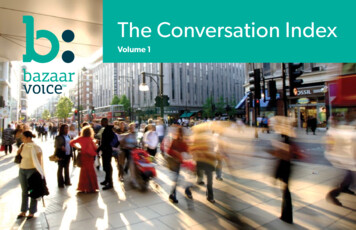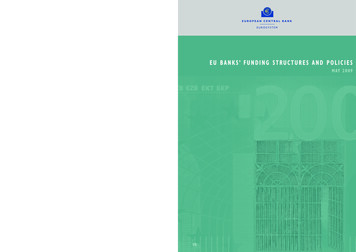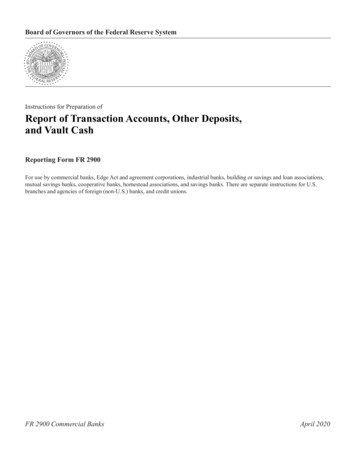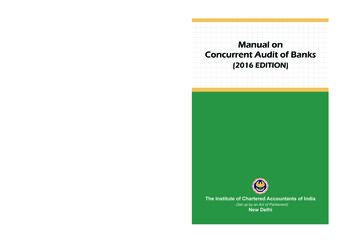
Transcription
Rating criteria for banksand financial institutionsJanuary 2022
Analytical contactsKrishnan SitaramanSenior Director & Deputy Chief Ratings Officerkrishnan.sitaraman@crisil.comSubha Sri eria contactsSomasekhar VemuriSenior Director and HeadRatings Criteria, Regulatory Affairs and Operationssomasekhar.vemuri@crisil.comRama PatelDirectorRating Criteria and Product Developmentrama.patel@crisil.comChaitali NehulkarAssociate DirectorRating Criteria and Product Developmentchaitali.nehulkar@crisil.comVishal KrishnaSenior ExecutiveRating Criteria and Product Developmentvishal.krishna@crisil.comIn case of any feedback or queries, you may write to us at criteria.feedback@crisil.com2
Executive summaryThe financial sector in India continues to be dominated by banks, despite inroads made by non-banking financialcompanies. They account for the bulk of lending, as reflected in their diversified loan books catering to householdsand corporates. On the liabilities side, banks attract low-cost deposits from retail customers and have built largebranch networks to cater to retail clients.Banks are highly regulated, and fall under the purview of the Reserve Bank of India (RBI). Credit growth andtransmission of policy rates are highly dependent on the performance of the banking system.CRISIL Ratings follows the CRAMEL framework for analysis of banks and financial institutions (FIs), which entailsthe assessment of capital adequacy, resource profile, asset quality, management, earnings and liquidity. In addition,market position is also factored. The criteria has been refined to make it more robust and comprehensive in terms ofassessment of various risks. The concepts explained in this criteria document broadly apply to FIs as well.Asset quality, capitalisation, earnings and resource profile are now considered the core parameters for theassessment of credit risk profiles of banks/FIs. Asset quality indicates the risk levels at which a bank /FI operates,while capitalisation indicates the cushion available to absorb potential losses that may arise due to the risks taken,and to ensure growth.Weakening in asset quality can eat into the earnings and, thereby, the capital cushion available to absorb losses,while adequate capitalisation can help absorb losses and ensure sustainable loan growth.Earnings indicate the ability to appropriately price risks and generate risk-adjusted returns, and augment the capitalbase. Resource profile is determined by the cost and stability of funds, which are key to smooth functioning andmaintaining operational stability.The ratings are typically anchored around the assessment of core parameters. Other aspects such as marketposition, liquidity and management are considered supplementary and may have limited influence on uplifting theratings compared with core parameters, but may constrain the ratings in certain situations.CRISIL Ratings believes managing environmental, social, and governance (ESG) risks and opportunities will have abearing on the credit risk profile of an issuer. Based on materiality and adequacy of data on ESG factors, CRISILRatings will assess and suitably factor in the ESG profile of banks and FIs in its credit risk analysis.ScopeThis criteria document1 highlights the CRISIL Ratings approach to assessing the credit quality of banks and all-Indiafinancial institutions (AIFIs). CRISIL Ratings uses the CRAMEL framework to rate banks and FIs, as well as otherfinancial companies.The methodology outlined in this document is used to arrive at the standalone rating of a bank/FI. For public sectorbanks and AIFIs, CRISIL Ratings may notch up the standalone rating for support from the government. The extent1The previous version of the criteria that was published in November 2020 can be accessed teria -banks-and-financial-institution-nov2020.pdf3
of notch-up is driven by the criteria for notching up standalone ratings of entities based on government support, whichcan be found on the CRISIL website, www.crisil.com.MethodologyThe CRISIL Ratings approach to rating banks and FIs involves a comprehensive assessment of severalparameters. Some core parameters have a high influence on the credit quality while others are consideredsupplementary.Core parameters(high influence on credit risk profile of a bank/FI)Asset qualityCapitalisationEarningsResource profileSupplementary parameters(degree of influence lower than core parameters to uplift the rating, but may constrain the rating)Market positionLiquidityManagement profileCRISIL Ratings takes a forward-looking view on the performance of an entity on these parameters while evaluatingits rating.Core parametersCRISIL Ratings considers asset quality, capitalisation, earnings and resource risk profile as the core parameters thatdrive the credit risk profile of a bank /FI. The interplay of these parameters determines the ability to underwrite, priceand manage risks, maintain adequate capital to absorb losses during times of stress, and ensure profitable growth.The standalone rating will be typically anchored to the assessment on these parameters.Asset qualityWeakening in asset quality could lead to higher credit costs, which can impact returns and erode the headroomavailable in the capital structure to absorb losses. Eventually, these can impact growth prospects and affect solvency.4
The asset quality assessment is driven by the level of gross non-performing assets (GNPAs) and the potential stressin the standard book. Write-offs and recoveries are also considered.Banks lend to a wide range of asset classes with varying risk profiles. For instance, retail loans have traditionallydisplayed lower delinquency profiles and volatility, and are considered less risky compared with agricultural loans orloans to micro, small and medium enterprises (MSMEs).Hence, CRISIL Ratings analyses the asset quality of the asset classes to which banks/FIs extend credit―retail,agriculture entities, MSMEs, and corporates―for a comprehensive understanding of the portfolio quality.Any expected improvement or weakening in the asset quality based on the economic environment and underwritingpolicies is also factored in the assessment. Diversification of the loan book across asset classes, volatility in GNPAs,and geographic and borrower concentration are also considered.Corporate loan bookAsset quality assessment of the corporate loan book takes into account NPAs in corporate loans and stressed assetsin the standard book. While the reported NPAs indicate the track record of asset quality in the corporate loan book,stressed assets in the standard book reflect the outlook on asset quality, in terms of potential slippages to NPAs overthe medium term.Assessment of stressed assets in the standard book is based on the credit risk profiles of the top exposures, and therating and sectoral distribution of the loan book. Track record of slippages, provision coverage ratio (PCR) andrecovery prospects are also considered.Retail, agriculture and MSME loansAsset quality assessment of such loans are driven by GNPAs. Within retail loans, various segments—home loans,secured loans (such as vehicle and gold loans), and unsecured loans (such as credit card loans and personal loan)—are analysed for a wholesome view of the asset quality, as each of these asset classes can have different credit riskprofiles.The assessment factors in typical delinquency levels, volatility in GNPAs and potential recoveries from these assetclasses. As asset quality indicators can be distorted by growth, NPAs are studied on a lagged basis.Capital adequacyCapital provides the cushion to withstand credit and other risks in business. Adequate capitalisation helps in tidingover asset-quality stress and maintaining credit growth. While rating banks/FIs, CRISIL Ratings analyses the capitaladequacy and its sustainability over the medium-to-long term.Capital adequacy is viewed relative to regulatory requirement of capital. For instance, the adequacy of CommonEquity Tier I capital (as required under the Basel III framework) is a key input in the assessment of capital adequacy.A cushion over the minimum regulatory capital requirement can enable the bank/FI to better support credit growth,and is considered in the capitalisation assessment.5
A forward-looking view is taken on the sustainability of capital, based on profitability, growth plans, asset quality andflexibility to raise capital. CRISIL Ratings also considers adherence to other regulatory capital norms: Tier 1capitalisation, overall capital requirement and the leverage ratio.EarningsEarnings are key to augmenting the capital required to support growth and absorb losses and indicate the ability toprice anticipated risk. Earnings also directly influence the ability to attract capital.CRISIL Ratings considers return on assets (RoA) as a critical indicator of earnings. This ratio encompasses all thebuilding blocks of profitability that indicate how efficient the bank/FI is in managing its: Pricing (as indicated by yield on assets) Operations (operating expenses)Asset quality (credit costs)Fund raising (cost of funds)Stability and sustainability of the RoA are also factored in the assessment. The trend in profitability at the gross profitlevel is examined to form a view on the sustainability of earnings. The level of pre-provisioning operating profit isconsidered to gauge the ability to absorb credit costs.Diversity of income sources is an important input in analysing the stability of earnings. Diversity in fund-based incomeis achieved by focusing on different borrower segments such as industries, trade and retail. Banks also diversify theirincome streams through non-interest or fee income, such as guarantees, cash management facilities, servicecharges from retail customers, and trading income. Fee income provides a cushion to profitability, especially in timesof pressure on interest spreads.The impact of PCR on future profitability is gauged. For instance, low PCR would indicate insufficient provisioning tocover potential losses from NPAs, which can affect profitability.Resource profileResource profile indicates the ability to mobilise stable funds at competitive rates to operate the business. Theresource composition of a bank is very different from that of an FI. Banks are significantly deposit-funded whereasFIs depend on wholesale funds. While some FIs do raise retail funds, they are at a natural disadvantage comparedwith the banking sector, because of restrictions on minimum tenure and interest rates, the absence of cheque-issuingfacility, and relatively small branch network.In general, dependence on wholesale funding attaches a degree of risk to the funding profile of FIs. High reliance onsuch funding is considered disadvantageous compared with retail deposits, due to higher concentration risks andgreater probability of run-off during stress scenarios in comparison to retail funding. These risks (especially stabilityof resources) are mitigated by the ability of AIFIs to mobilise resources from provident funds and insurance, whichhave access to long-tenure funds.6
Unlike FIs, retail deposits form an important source of funding for banks. Assessment of the resource profile is centredon the ability of the bank to access stable funding (indicated by retail deposit franchise) and funding at competitivecosts (indicated by CASA [current account and savings account] deposits). Reliance on capital market borrowings isalso considered.Given that FIs are predominantly wholesale-funded, the diversity in investors (both domestic and international) maymitigate resource risks. FIs that are dependent on a few investors are viewed less favourably than those that have alarge investor base.Some leading FIs regularly raise bonds and deposits from retail investors, which impart stability to the funding mix.The trend of raising funds from retail resources is favourably factored into the risk evaluation. Any sustainable formof tax-related or regulatory benefits that are accorded by the sovereign to the entity’s bond programme will influenceits resource profile favourably.The growing importance of ESG risks and opportunitiesThe past few years have seen the emergence of ESG-led investments globally. ESG investments account for abouta third of global assets under management and are expected to grow more than 2.5 times to 100 trillion by 2030.Investments in emerging markets, pegged at 15% in these global funds, are likely to reflect a similar trend, therebysignificantly improving access to funds for ESG-focused entities. While ESG-led investing is at a nascent stage inIndia, its adoption is steadily picking pace. CRISIL Ratings believes ESG readiness will, in time, become an importantdistinguishing feature for banks and FIs to diversify their resource profile.Banks and FIs have limited direct environmental impact and have a reasonable social impact because of theirsubstantial employee and customer base, and their key role in promoting financial inclusion. Given the nature of thesector, strong governance is pivotal in this sector for long-term sustainable operations and is a key determinant ofthe credit rating. Furthermore, the lending decisions could have a bearing on environmental factors and henceaffect their overall ESG profile.Non-financial disclosures are still evolving. Some of the large corporates have been early adopters, voluntarilytracking and disclosing their ESG-related parameters and policies. Disclosure levels in India are, however, expectedto improve―the Securities and Exchange Board of India (SEBI) circular on Business Responsibility and SustainabilityReporting dated May 10, 2021, requires the top 1,000 listed corporates to disclose significant non-financialinformation on a voluntary basis in fiscal 2022 and compulsorily from fiscal 2023. Improving data availability andability to benchmark non-financial parameters will help suitably factor in ESG risks in credit assessment and otherinvestment decisions.Factoring the impact of ESG in credit ratingsAs investors begin to screen investments through the ESG lens, CRISIL Ratings believes the ability of an issuer tomanage ESG related risks will have a bearing on its resource profile. This will specifically hold true for issuers thatare accessing the global pool of capital to meet their funding needs. Based on materiality, CRISIL Ratings will assessthe impact of the ESG risk of issuers, subject to availability of information. Parameters such as proportion of foreigninvestment holding and reliance on external market borrowings will be considered in assessing the materiality of ESGfor an issuer.CRISIL Ratings will assess parameters, such as emissions and energy consumption, water usage, wastemanagement for assessment of the environmental impact. In addition, the sectors to which banks and FIs lend will7
also be assessed as such lending can have an indirect bearing on the environment. Under social assessment,information pertaining to human capital, product and customer management, vendor management and communityengagement will be evaluated. Under governance, the board performance, ownership concentration, shareholderrelations, and disclosures and financial statements will be assessed. CRISIL Ratings may look at a specificcombination of these parameters based on the materiality and availability of information.CRISIL Ratings believes improvement in non-financial disclosures will be critical to increase the scope of integratingESG into credit risk assessment.Supplementary parametersCRISIL Ratings considers market position, management and liquidity as supplementary parameters; these havelimited ability to uplift the rating based on the core parameters, but can constrain the rating in certain situations.Market positionMarket position assesses the predictability of business volume in the face of potential economic and marketfluctuations. A strong market position provides benefit in terms of operating leverage and pricing power. The abilityto tap a vast consumer base enables a bank to continuously replenish its portfolio and provides avenues for crossselling and diversification.The key factor on which market position is assessed is the market share of the bank /FI in the industry. In addition tothe market share in assets, the share in deposits is also considered to factor in the strength of the liabilities franchiseof a bank.Other parameters such as sustainability of market share assessed through brand and franchise strength, scalabilityin terms of size, business outlook and growth potential, and diversification across the spectrum of financial servicesare also considered.ManagementAnalysis of the quality of the management, its business strategies, and ability and track record in responding tochanges in market conditions, risk appetite and competency forms a key input in the credit risk assessment.Evaluation of the management entails understanding the goals, philosophies, and strategies that drive the businessand financial performances.LiquidityBanks are required to maintain a minimum liquidity coverage ratio (LCR), in line with RBI regulations. LCR measuresthe ability to meet any net funding run-off by using high-quality liquid assets over a 30-day period of stress.8
CRISIL Ratings considers the cushion over the regulatory LCR requirement in its assessment of a bank’s liquidity. Ifthe LCR is close to the regulatory minimum, the LCR calculations are sensitised, if required, based on asset liabilitymanagement (ALM) of the bank. Any regulatory relaxations provided by RBI from time to time are also considered.Liquidity assessment of FIs factors in the ALM profile, including the cumulative mismatches in various maturitybuckets. The quantum of liquid assets maintained by the FI and its financial flexibility are also considered.Government supportCRISIL Ratings positively factors in government support for FIs that have a policy role to play in the economy.Furthermore, public sector banks benefit from the high likelihood of support arising from government ownership. Thelikelihood of government support is underpinned by strong policy and moral imperatives, given the role that the publicsector banking system plays in the economy.Banks are the primary agencies for channelling savings and the government uses the banking system to fulfil itseconomic and social agenda through priority-sector lending. While the government has stepped in to rescue troubledprivate sector banks in the past, the support to public sector banks would unquestionably be of a higher order asdemonstrated by capital infusion over the years.Assets of public sector banks constitute close to two-third of the assets and deposits in the banking system. Moreover,government ownership and control of banks is a politically sensitive issue, and the government will find it difficult todeny support to public sector banks in distress.For details, refer to ‘Criteria for notching up standalone ratings of entities based on government support’ availableon www.crisil.com.ConclusionCRISIL Ratings uses the CRAMEL framework to rate banks/FIs. Asset quality, capitalisation, earnings and resourceprofile are considered core parameters that drive the ratings. These parameters significantly determine the ability tounderwrite, price and manage risks, while maintaining adequate capitalisation to absorb losses and ensure creditgrowth. The supplementary parameters considered are market position, liquidity and management.9
About CRISIL LimitedCRISIL is a leading, agile and innovative global analytics company driven by its mission of making markets function better.It is India’s foremost provider of ratings, data, research, analytics and solutions, with a strong track record of growth, cultureof innovation and global footprint.It has delivered independent opinions, actionable insights, and efficient solutions to over 100,000 customers.It is majority owned by S&P Global Inc, a leading provider of transparent and independent ratings, benchmarks, analyticsand data to the capital and commodity markets worldwide.About CRISIL RatingsCRISIL Ratings is part of CRISIL Limited (“CRISIL”). We pioneered the concept of credit rating in India in 1987. CRISIL isregistered in India as a credit rating agency with the Securities and Exchange Board of India (“SEBI”). With a tradition ofindependence, analytical rigour and innovation, CRISIL sets the standards in the credit rating business. We rate the entirerange of debt instruments, such as, bank loans, certificates of deposit, commercial paper, non-convertible / convertible /partially convertible bonds and debentures, perpetual bonds, bank hybrid capital instruments, asset-backed and mortgagebacked securities, partial guarantees and other structured debt instruments. We have rated over 24,500 large and midscale corporates and financial institutions. CRISIL has also instituted several innovations in India in the rating business,including rating municipal bonds, partially guaranteed instruments and microfinance institutions. We also pioneered aglobally unique rating service for Micro, Small and Medium Enterprises (MSMEs) and significantly extended the accessibilityto rating services to a wider market. Over 1,10,000 MSMEs have been rated by us.CRISIL PrivacyCRISIL respects your privacy. We may use your contact information, such as your name, address, and email id to fulfil yourrequest and service your account and to provide you with additional information from CRISIL. For further information on CRISIL’sprivacy policy please visit www.crisil.com/privacy.Argentina China Hong Kong India Poland Singapore UAE UK USACRISIL Limited: CRISIL House, Central Avenue, Hiranandani Business Park, Powai, Mumbai – 400076. IndiaPhone: 91 22 3342 3000 Fax: 91 22 3342 3001 www.crisil.com
Rama Patel Director Rating Criteria and Product Development rama.patel@crisil.com Chaitali Nehulkar Associate Director Rating Criteria and Product Development chaitali.nehulkar@crisil.com vishal.krishna@crisil.com Vishal Krishna Senior Executive In case of any feedback or queries, you may write to us at criteria.feedback@crisil.com










